What Is A Food Desert?
A food desert is a geographical area where it is difficult to buy healthy, nutritious food at an affordable price. Food deserts include areas where travel to a grocery store is difficult, and in areas where healthy food may be available, but at an unaffordable price.
Despite it being our nation’s capital, Washington D.C. has many areas that are food deserts.
Learn more: What Are Food Deserts?
Fast Facts About Food Deserts in Washington D.C.
- Around 11% of D.C.’s land area is considered a food desert. This is equal to about 6.5 miles (D.C. Policy Center)
- Nearly half of the food deserts in D.C. occur in a single area, Ward 8.
Why Are There Food Deserts In D.C.?
Food deserts are a socio-economic problem that tend to occur in specific neighborhoods as a result of a lack of proper aid and investment in that neighborhood.
Food deserts are found in D.C. in neighborhoods with high poverty levels. These areas have lower access to transportation, making it more difficult to get to a grocery store.
Food deserts are also disproportionately found in areas where the residents have lower levels of education and high unemployment rates. Areas with food deserts also have high rates of abandoned or vacant buildings.
Food deserts are more likely to occur in primarily Black communities in D.C.. A national 2014 study showed that even in areas of equal poverty, Black communities are less likely than communities of other races to have access to grocery stores and fresh food (Bower et al. 2014).
Where Are There Food Deserts In D.C.?
Areas in D.C. with low-income and low-access to stores, as well as low vehicle access are food deserts.
This map provides an overview of where food deserts are located in the city of D.C. and surrounding areas. Any area showing color is a food desert. These areas closely overlap with low-income areas.
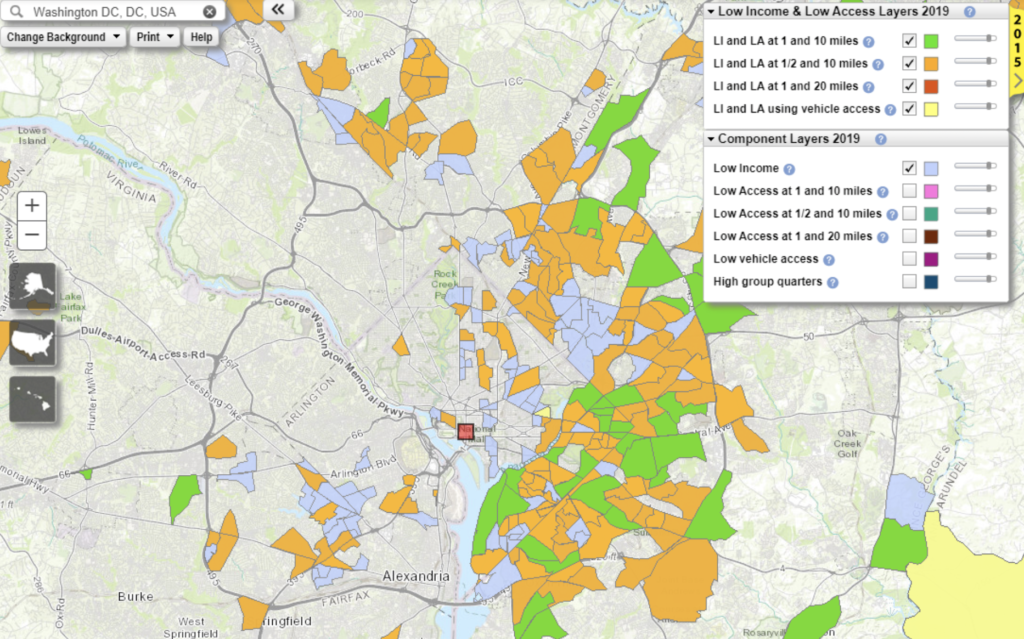
The map below provides a more zoomed-in view of food deserts in D.C. by ward, small districts of DC. Source: D.C. Policy Center
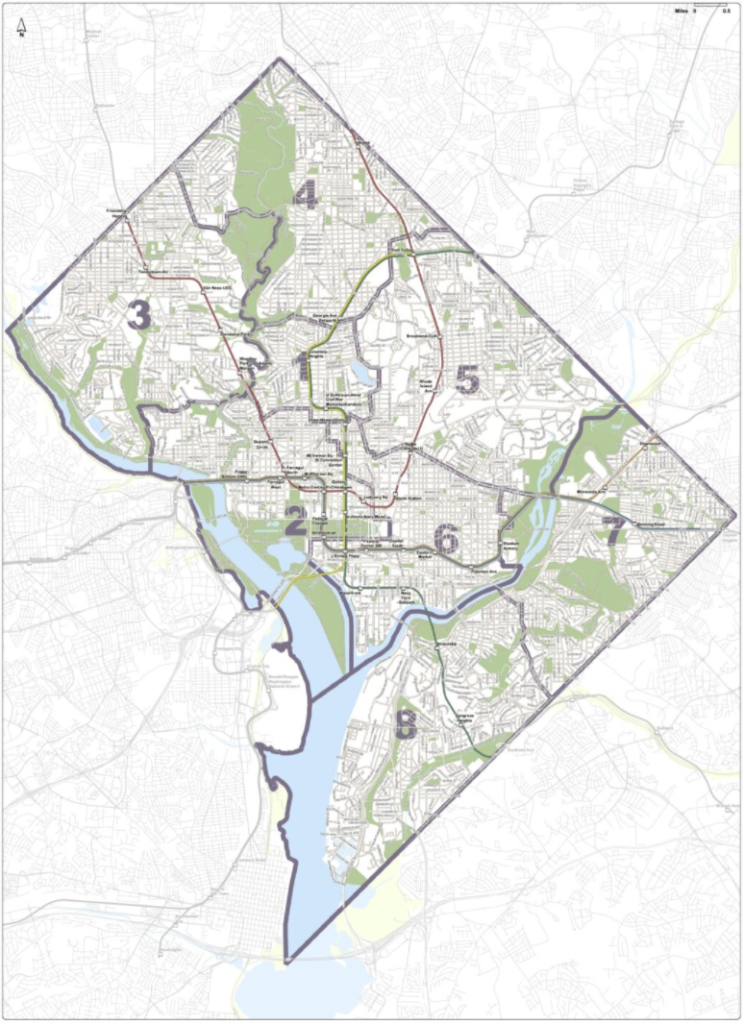
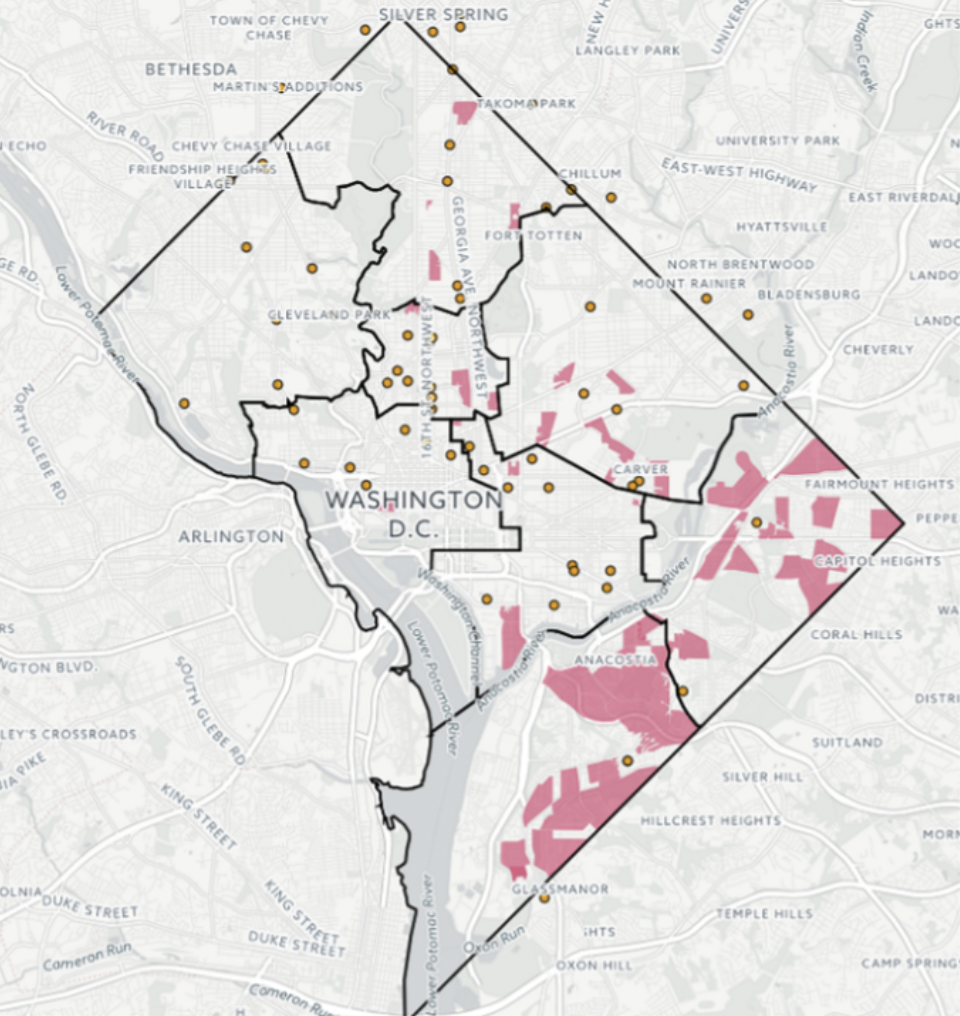
Food deserts in D.C. primarily occur east of the Potomac River in Wards 7 and 8. This map shows the lack of grocery stores (orange dots) and high number of convenience stores (blue dots) east of the river in areas that are food deserts.
Half of the food deserts in D.C. are located in Ward 8 (Smith 2017).
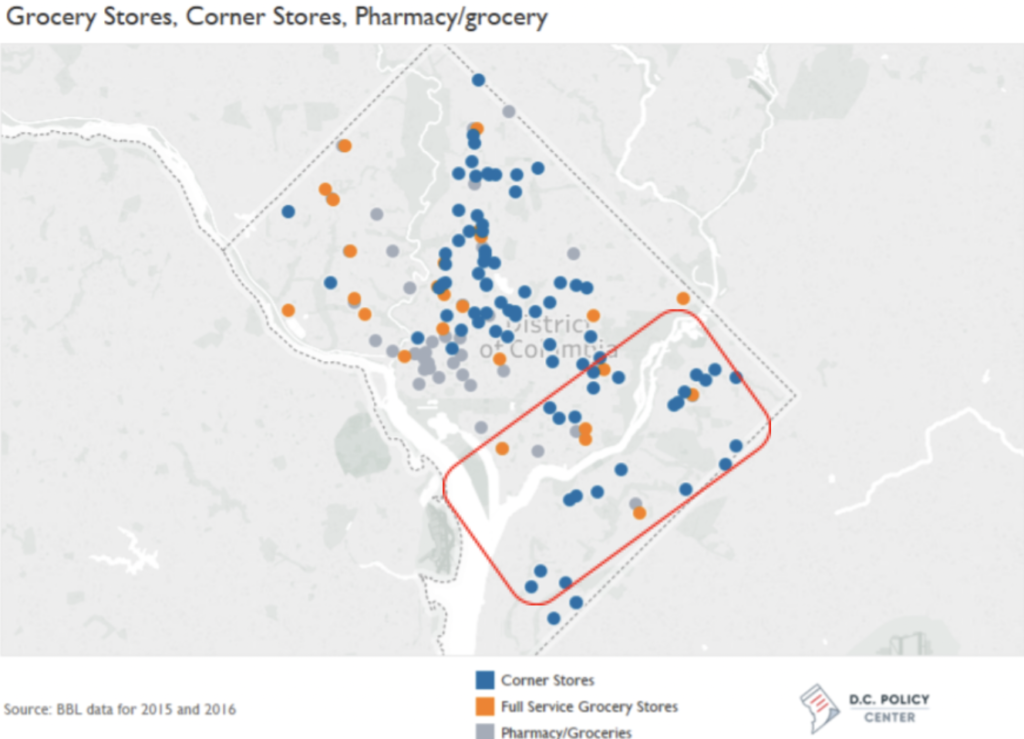
The areas with very few grocery stores line up closely with areas of low income. The map below shows that the area east of the river, wards 7 and 8, are amongst the lowest incomes in the city.
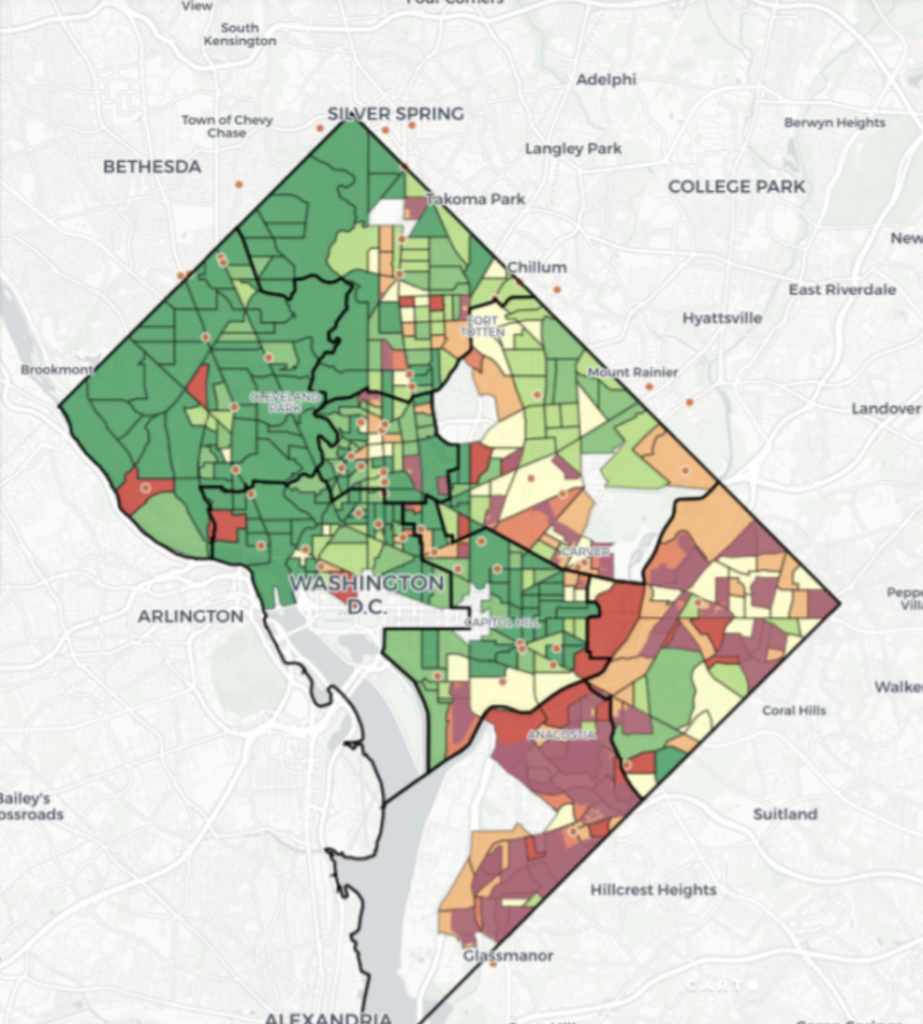

Lastly, the food desert areas also align with areas of low car access. This map shows areas where high percentages of residents do not have access to a car (noted in dark purple).
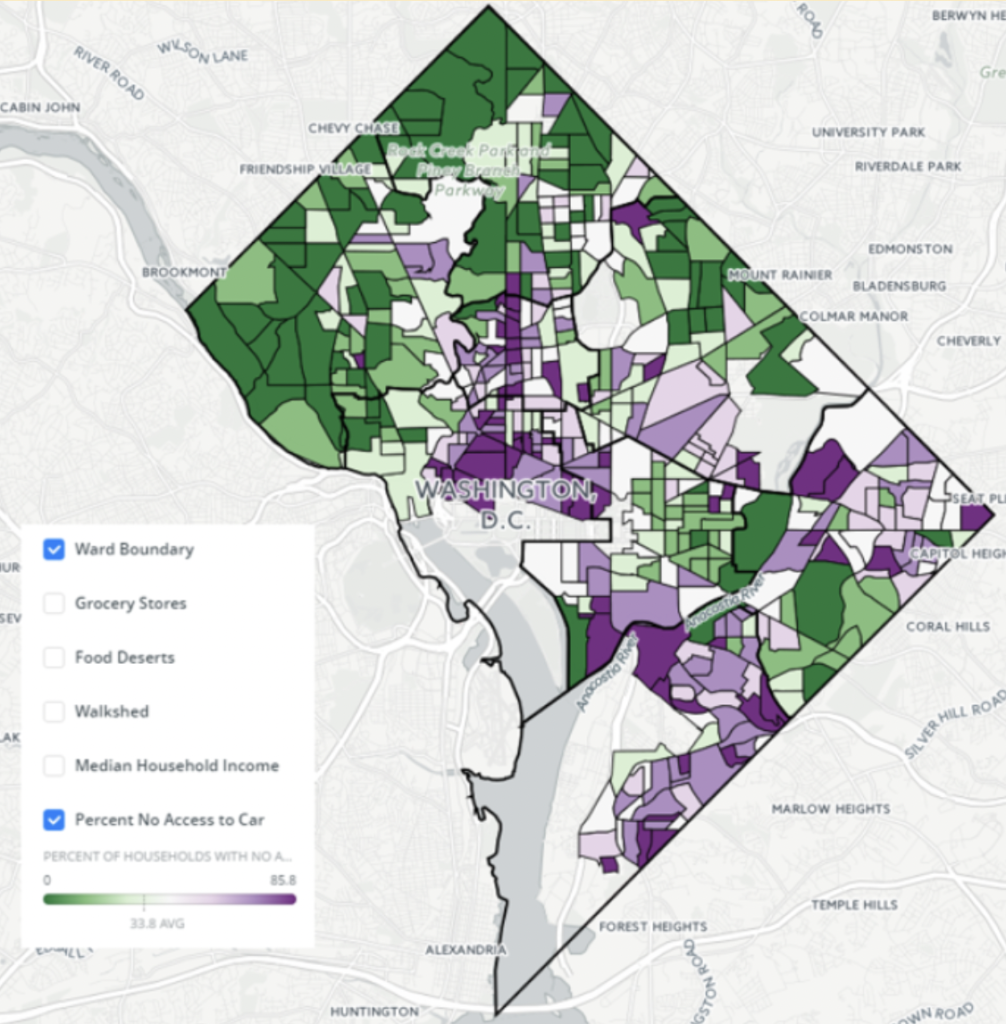
Solutions
The first step in disrupting food deserts in D.C. is researching where food deserts exist. The D.C. Policy Center is leading the way with their research identifying high poverty areas, areas with low transportation access, and areas with very few grocery stores.
Beyond research, multiple solutions are needed to address food deserts.
Increasing the Number of Grocery Stores
The spread of grocery stores in D.C. is highly uneven, with only two out of 49 located in Ward 7, and only one in Ward 8. A simple solution to the problem of food deserts in D.C. is to increase the number of grocery stores in these areas.
However, simply increasing the number of grocery stores is not a full solution, as even if grocery stores are accessible, it does not mean that residents can afford the food there.
Non-profit grocery stores help increase access to healthy food while keeping food affordable. These are often government funded and/or run by the city.
Another non-profit grocery option that keeps grocery prices low is a grocery cooperative, in which residents of a food desert own and run the store as a cooperative. The Community Grocery Co-Op is one such example bringing fresh food to residents east of the river in DC. However, this does require member fees to operate, which makes it more difficult to create in low-income communities.
Increased Access To Vehicles And Other Public Transportation Systems
In addition to creating more healthy food options locally, increasing transportation options can help reduce food deserts.
One method to increase transportation to grocery stores is to build up better public transportation. This may include adding a bus stop or even creating a shuttle system within the town.
Additionally, Lyft ride sharing created the Grocery Access Program to discount the cost of rides to grocery stores. This program has been piloted successfully in Washington D.C. in 2019, and has since expanded to other cities.
Other Solutions
Other solutions that could help eliminate food deserts in the city of D.C. include:
- Financial incentives and support for neighborhood-based grocery stores and farmers markets with discounted prices
- Increased financial assistance for residents of food deserts to buy food
- Increased community gardens and urban farming
- Restrictions on where dollar stores can be, as they displace grocery stores
- Increased public health education to encourage healthy eating
Some of these solutions are already being implemented.
Case Study: Ward 8
Ward 8 is one of eight geographic districts in Washington D.C. It lies east of the Potomac River. While the area was originally farmland, it is now mainly residential.
Ward 8 encompasses a number of different neighborhoods including Anacostia, Woodland, and Bellevue.

Ward 8 is considered a food desert. In fact, 46% of all food deserts in D.C. are in Ward 8. This is due to low access to transportation, very few grocery stores, and low-incomes. Between 2010-2020, Wards 7 and 8 lost four out of seven grocery stores, while the other wards gained 37 grocery stores.
Ward 8 follows the classic characteristics of where food deserts are most commonly found. Compared to the rest of the D.C. metropolitan area, Ward 8 has a lower education level, lower income, and a larger non-white community.
- Only 10.26% of Ward 8 residents have a Bachelor’s Degree, compared to 25.28% of people in the D.C. area.
- The median income in Ward 8 is $39,473 while the median income in the rest of D.C. is $91,414.
- 26.61% of families in Ward 8 live below the poverty line, compared to only 12.05% of families in the rest of D.C.
- 91.84% of Ward 8 residents are Black compared to 43.9% of the people in D.C.
(Source: D.C. health Matters).
Many solutions have been suggested to increase Ward 8 residents’ access to healthy food.
While a tax-incentive program, Feed DC Act, was passed to try and increase grocery stores in food deserts, very few stores were actually opened in the wards that need it most.
Tax incentives were ineffective in bringing grocery stores to Ward 8, so other programs have sprung up in response.
For example, a new affordable grocery store recently opened in Ward 8 that is run by the nonprofit chain Good Food.
Good Food uses funding from their parent nonprofit, Oasis Community Partners, in addition to funding from local governments to open in low-income communities where other grocery stores are hesitant to open. The market is staffed primarily by residents of the area.
Additionally, there are many nonprofit programs focused on providing healthy food to residents of Wards 7 and 8 in other ways. For example, the Arcadia Center for Sustainable Food and Agriculture is a nonprofit organization that runs a farm and a mobile market, as well as several farm-based educational programs.
DC Greens is another nonprofit focused on increasing health equity in D.C. In addition to working directly with community members, the organization works to change food policy in order to better support residents in food deserts.
To truly disrupt food deserts in Ward 8, a wide variety of solutions is necessary.